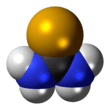Selenourea
Selenourea is the organoselenium compound with the formula SeC(NH2)2. It is a white solid. This compound features a rare example of a stable, unhindered carbon-selenium double bond. The compound is used in the synthesis of selenium heterocycles. Compared to urea, the oxo-analog of selenourea, few studies have been done on the compound due to the instability and toxicity of selenium compounds.[1] Selenourea is toxic if inhaled or consumed.
| |||
| Identifiers | |||
|---|---|---|---|
3D model (JSmol) |
|||
| ChEBI | |||
| ChemSpider | |||
| ECHA InfoCard | 100.010.119 | ||
| EC Number |
| ||
| MeSH | C081959 | ||
| UNII | |||
CompTox Dashboard (EPA) |
|||
| |||
| |||
| Properties | |||
| CH4N2Se | |||
| Molar mass | 123.02 g/mol | ||
| Appearance | Pink/grey solid | ||
| Melting point | 214 °C (417 °F; 487 K) | ||
| Boiling point | 200 °C (392 °F; 473 K) | ||
Except where otherwise noted, data are given for materials in their standard state (at 25 °C [77 °F], 100 kPa). | |||
| Infobox references | |||
Synthesis
The compound was first synthesized in 1884 by Auguste Verneuil by the reaction of hydrogen selenide and cyanamide:[2]
- H2Se + NCNH2 → SeC(NH2)2
While this reaction has even found use in industrial synthesis of selenourea,[3] more modern methods concern themselves with synthesis of substituted selenoureas. These can be synthesized using organic isoselenocyanates and secondary amines:
- RN=C=Se + NHR′R″ → Se=C(NRH)(NR′R″H)
Alternatively, a substituted carbodiimide could be used as follows:[1]
- RN=C=NR′ Se=C(NRH)(NR′H)
Properties
X-ray crystallographic measurements on crystals at −100 °C give average C=Se bond lengths of 1.86 Å, and 1.37 Å for C−N. Both the Se−C−N and N−C−N angles were measured at 120°, as expected for an sp2-hybridized carbon. Through these same studies, the existence of Se−H hydrogen bonding in the crystal lattice—suggested from the O−H and S−H hydrogen bonding found in crystals of urea and thiourea—was confirmed.[4]
Both the shortened length of the N−C bond and the longer Se=C bond suggest a delocalization of the lone pair on the amines; the Se=C π-bonding electrons are drawn towards the selenium atom, while the nitrogen's lone pair is drawn towards the carbonyl carbon. A similar effect is observed in urea and thiourea. In going from urea to thiourea to selenourea the double bond is more delocalized and longer, while the C−N σ bond is stronger and shorter. In terms of resonance structures, the selenol form (structures II, III) is more prevalent compared to urea and thiourea analogs; however, the lone pair the nitrogen of selenourea delocalizes only slightly more than the lone pair on thiourea (in contrast to a much greater delocalization in going from urea to thiourea).[5] These minor differences suggest that the properties emergent from the delocalized nitrogen lone pair and destabilization of the C=S and C=Se π bond in thiourea and selenourea will also be similar.
Unlike urea and thiourea, which have both been researched extensively,[1] relatively few studies quantitatively characterize selenourea. While the selone tautomer (I) has been shown to be the more stable form,[6] mainly qualitative and comparative information on selenourea's tautomerization is available.
In comparable manner to ketones, selones also tautomerize:
Since the greater delocalization of the lone pair electrons correlates with the selone product, the equilibrium position of selenourea likely has an equilibrium position comparable to thiourea's (which is lies more to the right that than urea's). Thiourea has been shown to exist predominantly in its thione form at 42 °C in dilute methanol, with the thionol tautomer almost nonexistent at neutral pH.[7]
Reactivity
An important class of reactions of selenourea is the formation of heterocycles. Some selenium-containing heterocycles exhibit antiinflammatory and antitumor activity, among other medicinal uses. Using selenourea as a precursor is considered to be the most efficient means of selenium-containing heterocyclic synthesis.[8]
Another class of reactions is the complexation of selenourea with transition metals and metalloids. Its ability to act as an effective ligand is attributed to the electron-donating effect of the amino groups and consequent stabilization of the selenium–metal π bond. In selenourea complexes only selenium–metal bonding has been observed, unlike in the urea and thiourea counterparts, which also bond through the nitrogen atom.[9]
References
- Koketsu, M.; Ishihara, H. (2006). "Thiourea and selenourea and their applications". Current Organic Synthesis. 3 (4): 439–455. doi:10.2174/157017906778699521.
- Hope, H. (1964). "Synthesis of selenourea". Acta Chemica Scandinavica. 18: 1800. doi:10.3891/acta.chem.scand.18-1800.
- Suvorov, V.; et al. (1996). "Production of selenourea of high purity". Vysokochistye Veshchestva. 3: 17–23.
- Rutherford, J. S.; Calvo, C. (1969). "The crystal structure of selenourea". Zeitschrift für Kristallographie. 128 (3–6): 229–258. doi:10.1524/zkri.1969.128.3-6.229.
- Hampson, P.; Mathias, A. (1968). "Nitrogen-14 chemical shifts in ureas". Journal of the Chemical Society B. 1968: 673–675. doi:10.1039/J29680000673..
- Rostkowska, H.; et al. (2004). "Proton transfer processes in selenourea: UV-induced selenone → selenol photoreaction and ground state selenol → selone proton tunneling". Chemical Physics. 298 (1–3): 223–232. doi:10.1016/j.chemphys.2003.11.024.
- Pramanick, D.; Chatterjee, A. K. (1980). "Thiourea as a transfer agent in the radical polymerization of methyl methacrylate in aqueous solution at 42°". European Polymer Journal. 16 (9): 895–899. doi:10.1016/0014-3057(80)90122-6.
- Ninomiya, M.; et al. (2010). "Selenium-containing heterocycles using selenoamides, selenoureas, selenazadienes, and isoselenocyanates". Heterocycles. 81 (9): 2027–2055. doi:10.3987/REV-10-677.
- Jones, P. G.; Thöne, C. (1991). "Preparation, crystal structures and reactions of phosphine(selenourea)gold(I) complexes". Chemische Berichte. 124: 2725–2729. doi:10.1002/cber.19911241213.



